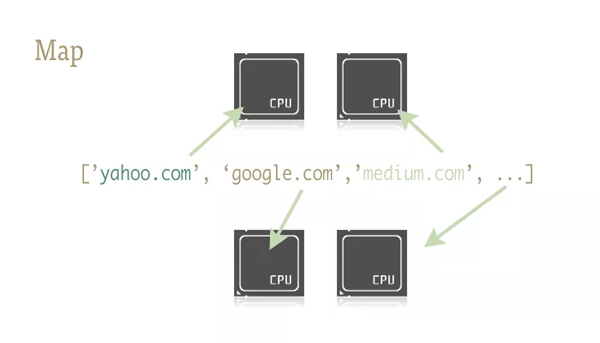一行代碼實現Python并行處理
Python 在程序并行化方面多少有些聲名狼藉。撇開技術上的問題,例如線程的實現和 GIL,我覺得錯誤的教學指導才是主要問題。常見的經典 Python 多線程、多進程教程多顯得偏"重"。而且往往隔靴搔癢,沒有深入探討日常工作中最有用的內容。
傳統(tǒng)的例子
簡單搜索下"Python 多線程教程",不難發(fā)現幾乎所有的教程都給出涉及類和隊列的例子:
- import os
- import PIL
- from multiprocessing import Pool
- from PIL import Image
- SIZE = (75,75)
- SAVE_DIRECTORY = 'thumbs'
- def get_image_paths(folder):
- return (os.path.join(folder, f)
- for f in os.listdir(folder)
- if 'jpeg' in f)
- def create_thumbnail(filename):
- im = Image.open(filename)
- im.thumbnail(SIZE, Image.ANTIALIAS)
- base, fname = os.path.split(filename)
- save_path = os.path.join(base, SAVE_DIRECTORY, fname)
- im.save(save_path)
- if __name__ == '__main__':
- folder = os.path.abspath(
- '11_18_2013_R000_IQM_Big_Sur_Mon__e10d1958e7b766c3e840')
- os.mkdir(os.path.join(folder, SAVE_DIRECTORY))
- images = get_image_paths(folder)
- pool = Pool()
- pool.map(creat_thumbnail, images)
- pool.close()
- pool.join()
哈,看起來有些像 Java 不是嗎?
我并不是說使用生產者/消費者模型處理多線程/多進程任務是錯誤的(事實上,這一模型自有其用武之地)。只是,處理日常腳本任務時我們可以使用更有效率的模型。
問題在于…
- 首先,你需要一個樣板類;
- 其次,你需要一個隊列來傳遞對象;
- 而且,你還需要在通道兩端都構建相應的方法來協助其工作(如果需想要進行雙向通信或是保存結果還需要再引入一個隊列)。
worker 越多,問題越多
按照這一思路,你現在需要一個 worker 線程的線程池。下面是一篇 IBM 經典教程中的例子——在進行網頁檢索時通過多線程進行加速。
- #Example2.py
- '''
- A more realistic thread pool example
- '''
- import time
- import threading
- import Queue
- import urllib2
- class Consumer(threading.Thread):
- def __init__(self, queue):
- threading.Thread.__init__(self)
- self._queue = queue
- def run(self):
- while True:
- content = self._queue.get()
- if isinstance(content, str) and content == 'quit':
- break
- response = urllib2.urlopen(content)
- print 'Bye byes!'
- def Producer():
- urls = [
- 'http://www.python.org', 'http://www.yahoo.com'
- 'http://www.scala.org', 'http://www.google.com'
- # etc..
- ]
- queue = Queue.Queue()
- worker_threads = build_worker_pool(queue, 4)
- start_time = time.time()
- # Add the urls to process
- for url in urls:
- queue.put(url)
- # Add the poison pillv
- for worker in worker_threads:
- queue.put('quit')
- for worker in worker_threads:
- worker.join()
- print 'Done! Time taken: {}'.format(time.time() - start_time)
- def build_worker_pool(queue, size):
- workers = []
- for _ in range(size):
- worker = Consumer(queue)
- worker.start()
- workers.append(worker)
- return workers
- if __name__ == '__main__':
- Producer()
這段代碼能正確的運行,但仔細看看我們需要做些什么:構造不同的方法、追蹤一系列的線程,還有為了解決惱人的死鎖問題,我們需要進行一系列的 join 操作。這還只是開始……
至此我們回顧了經典的多線程教程,多少有些空洞不是嗎?樣板化而且易出錯,這樣事倍功半的風格顯然不那么適合日常使用,好在我們還有更好的方法。
何不試試 map
map 這一小巧精致的函數是簡捷實現 Python 程序并行化的關鍵。map 源于 Lisp 這類函數式編程語言。它可以通過一個序列實現兩個函數之間的映射。
- urls = ['http://www.yahoo.com', 'http://www.reddit.com']
- results = map(urllib2.urlopen, urls)
上面的這兩行代碼將 urls 這一序列中的每個元素作為參數傳遞到 urlopen 方法中,并將所有結果保存到 results 這一列表中。其結果大致相當于:
- results = []
- for url in urls:
- results.append(urllib2.urlopen(url))
map 函數一手包辦了序列操作、參數傳遞和結果保存等一系列的操作。
為什么這很重要呢?這是因為借助正確的庫,map 可以輕松實現并行化操作。
在 Python 中有個兩個庫包含了 map 函數:multiprocessing 和它鮮為人知的子庫 multiprocessing.dummy.
這里多扯兩句:multiprocessing.dummy?mltiprocessing 庫的線程版克隆?這是蝦米?即便在 multiprocessing 庫的官方文檔里關于這一子庫也只有一句相關描述。而這句描述譯成人話基本就是說:"嘛,有這么個東西,你知道就成."相信我,這個庫被嚴重低估了!
dummy 是 multiprocessing 模塊的完整克隆,唯一的不同在于 multiprocessing 作用于進程,而 dummy 模塊作用于線程(因此也包括了 Python 所有常見的多線程限制)。
所以替換使用這兩個庫異常容易。你可以針對 IO 密集型任務和 CPU 密集型任務來選擇不同的庫。
動手嘗試
使用下面的兩行代碼來引用包含并行化 map 函數的庫:
- from multiprocessing import Pool
- from multiprocessing.dummy import Pool as ThreadPool
實例化 Pool 對象:
- pool = ThreadPool()
這條簡單的語句替代了 example2.py 中 buildworkerpool 函數 7 行代碼的工作。它生成了一系列的 worker 線程并完成初始化工作、將它們儲存在變量中以方便訪問。
Pool 對象有一些參數,這里我所需要關注的只是它的第一個參數:processes. 這一參數用于設定線程池中的線程數。其默認值為當前機器 CPU 的核數。
一般來說,執(zhí)行 CPU 密集型任務時,調用越多的核速度就越快。但是當處理網絡密集型任務時,事情有些難以預計了,通過實驗來確定線程池的大小才是明智的。
- pool = ThreadPool(4) # Sets the pool size to 4
線程數過多時,切換線程所消耗的時間甚至會超過實際工作時間。對于不同的工作,通過嘗試來找到線程池大小的最優(yōu)值是個不錯的主意。
創(chuàng)建好 Pool 對象后,并行化的程序便呼之欲出了。我們來看看改寫后的 example2.py
- import urllib2
- from multiprocessing.dummy import Pool as ThreadPool
- urls = [
- 'http://www.python.org',
- 'http://www.python.org/about/',
- 'http://www.onlamp.com/pub/a/python/2003/04/17/metaclasses.html',
- 'http://www.python.org/doc/',
- 'http://www.python.org/download/',
- 'http://www.python.org/getit/',
- 'http://www.python.org/community/',
- 'https://wiki.python.org/moin/',
- 'http://planet.python.org/',
- 'https://wiki.python.org/moin/LocalUserGroups',
- 'http://www.python.org/psf/',
- 'http://docs.python.org/devguide/',
- 'http://www.python.org/community/awards/'
- # etc..
- ]
- # Make the Pool of workers
- pool = ThreadPool(4)
- # Open the urls in their own threads
- # and return the results
- results = pool.map(urllib2.urlopen, urls)
- #close the pool and wait for the work to finish
- pool.close()
- pool.join()
實際起作用的代碼只有 4 行,其中只有一行是關鍵的。map 函數輕而易舉的取代了前文中超過 40 行的例子。為了更有趣一些,我統(tǒng)計了不同方法、不同線程池大小的耗時情況。
- # results = []
- # for url in urls:
- # result = urllib2.urlopen(url)
- # results.append(result)
- # # ------- VERSUS ------- #
- # # ------- 4 Pool ------- #
- # pool = ThreadPool(4)
- # results = pool.map(urllib2.urlopen, urls)
- # # ------- 8 Pool ------- #
- # pool = ThreadPool(8)
- # results = pool.map(urllib2.urlopen, urls)
- # # ------- 13 Pool ------- #
- # pool = ThreadPool(13)
- # results = pool.map(urllib2.urlopen, urls)
結果:
- # Single thread: 14.4 Seconds
- # 4 Pool: 3.1 Seconds
- # 8 Pool: 1.4 Seconds
- # 13 Pool: 1.3 Seconds
很棒的結果不是嗎?這一結果也說明了為什么要通過實驗來確定線程池的大小。在我的機器上當線程池大小大于 9 帶來的收益就十分有限了。
另一個真實的例子
生成上千張圖片的縮略圖
這是一個 CPU 密集型的任務,并且十分適合進行并行化。
基礎單進程版本
- import os
- import PIL
- from multiprocessing import Pool
- from PIL import Image
- SIZE = (75,75)
- SAVE_DIRECTORY = 'thumbs'
- def get_image_paths(folder):
- return (os.path.join(folder, f)
- for f in os.listdir(folder)
- if 'jpeg' in f)
- def create_thumbnail(filename):
- im = Image.open(filename)
- im.thumbnail(SIZE, Image.ANTIALIAS)
- base, fname = os.path.split(filename)
- save_path = os.path.join(base, SAVE_DIRECTORY, fname)
- im.save(save_path)
- if __name__ == '__main__':
- folder = os.path.abspath(
- '11_18_2013_R000_IQM_Big_Sur_Mon__e10d1958e7b766c3e840')
- os.mkdir(os.path.join(folder, SAVE_DIRECTORY))
- images = get_image_paths(folder)
- for image in images:
- create_thumbnail(Image)
上邊這段代碼的主要工作就是將遍歷傳入的文件夾中的圖片文件,一一生成縮略圖,并將這些縮略圖保存到特定文件夾中。
這我的機器上,用這一程序處理 6000 張圖片需要花費 27.9 秒。
如果我們使用 map 函數來代替 for 循環(huán):
- import os
- import PIL
- from multiprocessing import Pool
- from PIL import Image
- SIZE = (75,75)
- SAVE_DIRECTORY = 'thumbs'
- def get_image_paths(folder):
- return (os.path.join(folder, f)
- for f in os.listdir(folder)
- if 'jpeg' in f)
- def create_thumbnail(filename):
- im = Image.open(filename)
- im.thumbnail(SIZE, Image.ANTIALIAS)
- base, fname = os.path.split(filename)
- save_path = os.path.join(base, SAVE_DIRECTORY, fname)
- im.save(save_path)
- if __name__ == '__main__':
- folder = os.path.abspath(
- '11_18_2013_R000_IQM_Big_Sur_Mon__e10d1958e7b766c3e840')
- os.mkdir(os.path.join(folder, SAVE_DIRECTORY))
- images = get_image_paths(folder)
- pool = Pool()
- pool.map(creat_thumbnail, images)
- pool.close()
- pool.join()
5.6 秒!
雖然只改動了幾行代碼,我們卻明顯提高了程序的執(zhí)行速度。在生產環(huán)境中,我們可以為 CPU 密集型任務和 IO 密集型任務分別選擇多進程和多線程庫來進一步提高執(zhí)行速度——這也是解決死鎖問題的良方。此外,由于 map 函數并不支持手動線程管理,反而使得相關的 debug 工作也變得異常簡單。
到這里,我們就實現了(基本)通過一行 Python 實現并行化。




































